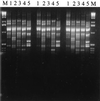Comparison of different PCR approaches for typing of Francisella tularensis strains
- PMID: 10698989
- PMCID: PMC86326
- DOI: 10.1128/JCM.38.3.1016-1022.2000
Comparison of different PCR approaches for typing of Francisella tularensis strains
Abstract
In this study, we evaluated three PCR methods for epidemiological typing of Francisella tularensis: repetitive extragenic palindromic element PCR (REP-PCR), enterobacterial repetitive intergenic consensus sequence PCR (ERIC-PCR), and random amplified polymorphic DNA (RAPD) assay with both M13 and T3-T7 primers. The analysis was performed with 40 strains of F. tularensis isolated from hares, humans, ticks, and a vole. On the basis of the combination of REP, ERIC, and RAPD fingerprints, F. tularensis strains were divided into 17 genetic groups (designated A to Q), and one Francisella novicida strain was classified in group R. The F. novicida strain is of special concern, since previous genetic methods have been unable to clearly distinguish between F. tularensis and F. novicida. The F. tularensis isolates recovered from hares were included in groups A to J, M, and P; those recovered from humans were included in groups A, D, G, J, L, O, and N; those isolated from ticks were included in groups B and Q; and that recovered from a vole was in group K. The diversities calculated for the 40 F. tularensis isolates, according to Simpson's index, were 0.14 for REP-PCR, 0.52 for ERIC-PCR, 0.39 for RAPD assay with the M13 primer (RAPD/M13-PCR), and 0.65 for RAPD/T3-T7-PCR, and the diversity increased up to 0.90 when ERIC-PCR, RAPD/M13-PCR, and RAPD/T3-T7-PCR were combined. Our results suggest that although limited genetic heterogeneity among F. tularensis strains was observed, this small variation is enough to validate the PCR methods used in this study and their combinations, because they can provide safe, useful, and rapid tools for the typing of F. tularensis.
Figures




References
-
- Bachiller Luque P, Pérez Castrillón J L, Martín Luquero M, Mena Martín F J, de la Lama López-Areal J, Pérez Pascual P, Mazón M A, Herreros Guilarte V. Preliminary report of an epidemic tularemia outbreak in Valladolid. Rev Clin Esp. 1998;198:789–793. - PubMed
-
- Bell J F, Owen C R, Larson C C. Virulence of Bacterium tularense: a study of Bacterium tularense in mice, guinea pigs, and rabbits. J Infect Dis. 1955;97:162. - PubMed
-
- Forsman M, Sandström G, Sjöstedt A. Analysis of 16S ribosomal DNA sequences of Francisella strains and utilization for determination of the phylogeny of the genus and for identification of strains by PCR. J Syst Bacteriol. 1994;44:38–46. - PubMed
-
- García Peña F J, Suárez Mayoral P, Cogolludo Cogolludo C, Arriola Garrote C, Anadón Navarro E. An outbreak of tularemia in Castilla-León. First isolation of Francisella tularensis in Spain. Med Vet. 1998;15:418–423.
Publication types
MeSH terms
LinkOut - more resources
Full Text Sources
Other Literature Sources
Molecular Biology Databases

